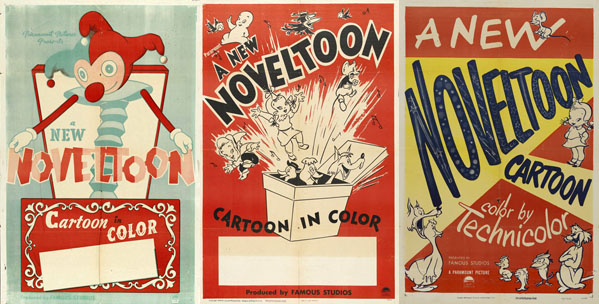
The Noveltoons series during the immediate postwar years must have been meeting considerable success. The cartoons still had some verve to them, and had not yet fallen into strict formula as we tend to think of Famous cartoons. One character who would be introduced around this time was Buzzy “The Funny Crow”, giving Jackson Beck the chance to do his impersonation of Eddie “Rochester” Anderson. (One currently “lost” title, Cat o’ Nine Ails, remains unavailable for this survey.) Herman the Mouse continued to star in larger roles, developing into episodes predicting some of the action which would later be accompanied by his regular feline foil, Katnip, who had not yet been designed. Raggedy Ann would make a final appearance, and Blackie the Black Sheep would cross-up Wolfie a few more times before being shelved. There was even an attempt to revive a King Features franchise previously attempted by Charles Mintz, using the strip’s new star, Snuffy Smith, in place of its nominal star Barney Google, who had been the center of the Mintz episodes. This attempt would not meet with success – but the studio would cross paths with the feudin’ hillbilly again in the television era, achieving a result much closer to its comic strip counterpart.
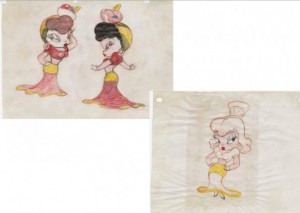 Sheep Shape (6/28/46) – Wolfie shows up outside of a night club, advertising “30 beautiful girls – no cover.” His only reaction – “Ngyang Ngyang Ngyang!” However, Wolfie’s pockets are empty, and he is unceremoniously kicked out of the place. He happens to see a newspaper, indicating that Blackie has raised $10,000 for an orphan’s home, and immediately decides to pay a call on Blackie to partake of such lucre. Wolfie does prevail in making off with the pot, and starts throwing money around like water, envisioning a life of wine, women, and song. He gets a ringside table, but encounters a sultry seductress (Blackie, in drag and a red wig), performing “I’m In the Mood For Love”, prompting a Tex Avarian reaction. After considerable girl chasing and explosive retaliations, the night club is blown up by a giant firecracker. Blackie recovers all the loot, and cannot help but taunt the wolf, by tugging on his arm like a slot machine, casing his eyes to roll like wheels, coming up with the word “Sucker”. Songs: “I’m In the Mood For Love” is revisited, and a new oldie, “Cielito Lindo”, a traditional Mexican song known to all for its “Ay Yi Yi Yi” chorus, which had experienced recent popularity in a swing version by the Mills Brothers on Decca. A “Mexican Tipica Orchestra” (as the recording was billed), had performed the tune for Victor back in 1926.
Sheep Shape (6/28/46) – Wolfie shows up outside of a night club, advertising “30 beautiful girls – no cover.” His only reaction – “Ngyang Ngyang Ngyang!” However, Wolfie’s pockets are empty, and he is unceremoniously kicked out of the place. He happens to see a newspaper, indicating that Blackie has raised $10,000 for an orphan’s home, and immediately decides to pay a call on Blackie to partake of such lucre. Wolfie does prevail in making off with the pot, and starts throwing money around like water, envisioning a life of wine, women, and song. He gets a ringside table, but encounters a sultry seductress (Blackie, in drag and a red wig), performing “I’m In the Mood For Love”, prompting a Tex Avarian reaction. After considerable girl chasing and explosive retaliations, the night club is blown up by a giant firecracker. Blackie recovers all the loot, and cannot help but taunt the wolf, by tugging on his arm like a slot machine, casing his eyes to roll like wheels, coming up with the word “Sucker”. Songs: “I’m In the Mood For Love” is revisited, and a new oldie, “Cielito Lindo”, a traditional Mexican song known to all for its “Ay Yi Yi Yi” chorus, which had experienced recent popularity in a swing version by the Mills Brothers on Decca. A “Mexican Tipica Orchestra” (as the recording was billed), had performed the tune for Victor back in 1926.

The Goal Rush (9/27/46) – Spot gags on football. There seems to have been a great number of cartoons on football put out in the post-war years. And in the professional field, there was rising competition from the NFL, which was an alternative to the All American Football Conference until 1949, when the latter conference was absorbed by the NFL. An old Fleischer gag resurfaces, as an on-field injury occurs, and an ambulance crew carries the ball away on a stretcher instead of the player. Songs: “Song of the Vagabonds”, with a special lyric written to provide a tie-in to the Army football team. The “Notre Dame Victory March” and “Anchors Aweigh” also appear, all three presented in a “follow the bouncing ball” sing-along format. “Song of the Vagabonds” was originally the featured march from “The Vagabond King”, recorded by Nat Shilkret and the Victor Orchestra for Victor. It was also recorded by Rudolf Friml, its composer, as a piano solo for Columbia. Art Tatum revived it in 1945, possibly on Comet Records. Album versions later included Mario Lanza on RCA Victor, and Gordon Macrae on Capitol. The Notre Dame Victory March was recorded most notably by the Notre Dame Band on Victor. “Anchors Aweigh” was recorded by the U.S. Marine Band on acoustic Victor in 1921 (embed below), using the complete musical chart including many strains from the 1906 chart ahead of the familiar verse, which are largely unfamiliar to the modern listener. Other recordings would concentrate on the verse, including Columbia Military Band in 1928 (reissued on Conqueror), the U.S. Navy Band for Victor in the same year, and the High Hatters for Victor in 1930 Phil Spitalny would release a cardboard version for Hit of the Week. A swing version appeared by Bob Crosby on Decca. The Goldman Band performed it for Columbia in 1942.
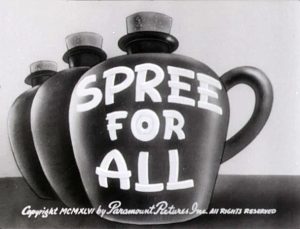 Spree For All (10/18/46) – Snuffy Smith (here voiced by Jack Mercer) is returning to his hole in the Great Smoky Mountains, presumably after serving in the war (as he had in lie action in some low-budget features produced during the conflict). Upon setting up his pre-fab house, complete with unfolding walkway to the front door and a pop-up mailbox, he immediately thinks he’s going to enjoy the peace and quiet of the hills. These thoughts are quickly dashed by flying bullets, as the Mulligans and the Coys are feuding on either side of Snuffy’s property line. Snuffy will have none of this, and decides to do a little shooting himself with some special ammunition – something that approaches a love potion. A male from one family sees a female of the other family, and declares he feels “peculiar”. He grabs her and proposes with the romantic words, “Let’s get hitched”. Sniffy decides to throw a celebration, stating, “You outlaws is going to become in laws”. Snuffy thinks all is settled, but pops a cork on a jug of white lightning. The pop is mistaken for a gunshot, and the rival families pull out the shootin’ irons again. Snuffy has had it, and again turns to his own rifle, shooting every which way to make both families pick up their houses bodily and head for other hills. Snuffy finally has his peace – though all four walls of his cabin have been blasted away in the crossfire. Read more about this film, and watch it, Click HERE!
Spree For All (10/18/46) – Snuffy Smith (here voiced by Jack Mercer) is returning to his hole in the Great Smoky Mountains, presumably after serving in the war (as he had in lie action in some low-budget features produced during the conflict). Upon setting up his pre-fab house, complete with unfolding walkway to the front door and a pop-up mailbox, he immediately thinks he’s going to enjoy the peace and quiet of the hills. These thoughts are quickly dashed by flying bullets, as the Mulligans and the Coys are feuding on either side of Snuffy’s property line. Snuffy will have none of this, and decides to do a little shooting himself with some special ammunition – something that approaches a love potion. A male from one family sees a female of the other family, and declares he feels “peculiar”. He grabs her and proposes with the romantic words, “Let’s get hitched”. Sniffy decides to throw a celebration, stating, “You outlaws is going to become in laws”. Snuffy thinks all is settled, but pops a cork on a jug of white lightning. The pop is mistaken for a gunshot, and the rival families pull out the shootin’ irons again. Snuffy has had it, and again turns to his own rifle, shooting every which way to make both families pick up their houses bodily and head for other hills. Snuffy finally has his peace – though all four walls of his cabin have been blasted away in the crossfire. Read more about this film, and watch it, Click HERE!
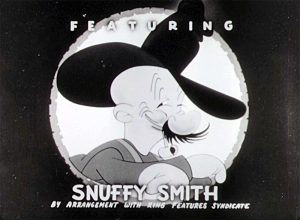 Song: “She’ll Be Comin’ Round the Mountain”, an old folk favorite, Henry Whitter recorded an acoustic version for Okeh. Gid Tanner and his Skillet Likkers would provide an electric version for Columbia, H.M. Barnes and his Blue Ridge Ramblers (a large hillbilly vaudeville group) would perform another classic version on Brunswick in the late 1920’s, The Pickard Family recorded it for ARC in about 1929, appearing on Conqueror. Vernon Dalhart recorded it on Edison, and possibly for other labels. Jimmie Wilson’s Catfish String Band recorded an electrical Victor in 1929. Frankie “Half-Pint” Jaxon recorded a “hot” version driven by string bass for Vocalion. The song was included in a short version as a bonus extra following a longer rendition of “Guilty” on Hit of the Week by Phil Spitalny and his Orchestra in the 1930’s. An excellent and odd radio transcription version in hi-fidelity was recorded for Lang-Worth by Fats Waller on the Hammond Organ, taken in deliberate slow stride. A 1940’s version was played deliberately corny by Abe Lyman on Brunswick (embed below). A square-dancing rendition appeared as part of a set by A; Macleod’s Country Dance Band on Decca. A lampoon version by Mickey Katz appeared on Capitol entitled, “She’ll Be Comin’ Round the Katzkills”. A short private tape of John Lennon even exists, giving him a chance to goof around and demonstrate his picking. Also featured in the film is Dream Lover, introduced by Jeanette MacDonald in Paramount’s 1929 feature, The Love Parade (Ernst Lubitch’s first Talkie). Jeanette recorded if for Victor black seal that year. For the dancing crowd, it was recorded by Ben Selvin for Columbia, and Nat Shilkret for Victor, Robert Farnon would revive it for London in the 1940’s Across the pond, it was covered by Gladys Moncrief on Regal – one of the most popular trained sopranos of Australia.
Song: “She’ll Be Comin’ Round the Mountain”, an old folk favorite, Henry Whitter recorded an acoustic version for Okeh. Gid Tanner and his Skillet Likkers would provide an electric version for Columbia, H.M. Barnes and his Blue Ridge Ramblers (a large hillbilly vaudeville group) would perform another classic version on Brunswick in the late 1920’s, The Pickard Family recorded it for ARC in about 1929, appearing on Conqueror. Vernon Dalhart recorded it on Edison, and possibly for other labels. Jimmie Wilson’s Catfish String Band recorded an electrical Victor in 1929. Frankie “Half-Pint” Jaxon recorded a “hot” version driven by string bass for Vocalion. The song was included in a short version as a bonus extra following a longer rendition of “Guilty” on Hit of the Week by Phil Spitalny and his Orchestra in the 1930’s. An excellent and odd radio transcription version in hi-fidelity was recorded for Lang-Worth by Fats Waller on the Hammond Organ, taken in deliberate slow stride. A 1940’s version was played deliberately corny by Abe Lyman on Brunswick (embed below). A square-dancing rendition appeared as part of a set by A; Macleod’s Country Dance Band on Decca. A lampoon version by Mickey Katz appeared on Capitol entitled, “She’ll Be Comin’ Round the Katzkills”. A short private tape of John Lennon even exists, giving him a chance to goof around and demonstrate his picking. Also featured in the film is Dream Lover, introduced by Jeanette MacDonald in Paramount’s 1929 feature, The Love Parade (Ernst Lubitch’s first Talkie). Jeanette recorded if for Victor black seal that year. For the dancing crowd, it was recorded by Ben Selvin for Columbia, and Nat Shilkret for Victor, Robert Farnon would revive it for London in the 1940’s Across the pond, it was covered by Gladys Moncrief on Regal – one of the most popular trained sopranos of Australia.

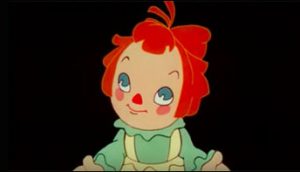 The Enchanted Square (5/9/47) – Raggedy Ann’s final appearance for the studio, as a rag doll found in the trash can by a cop on the beat, who presents the doll as a gift to a young girl born blind. The girl feels Raggedy Ann’s face, and an image of her features comes into her mind. Ann builds upon this, by enlarging the girl’s inner vision with images to match the everyday sounds she hears in the streets each day, transforming her inner world into a land of wonderment, amusement rides, and fanciful images. The film becomes exceptionally touching when the girl achieves her first “sight”: of her mother – though idealized far and above her real-life image as a poor widow. The officer (in a fine read by Jackson Beck) returns to view the happy girl, and remarks how there’s those who see with the eyes in their head, and those that see with the eyes in their heart – “and that’s the lord’s own truth.” Song: “You Can See With Your Heart”, an original for the film, composers unknown, and an organ-grinder version of Cielito Lindo.”
The Enchanted Square (5/9/47) – Raggedy Ann’s final appearance for the studio, as a rag doll found in the trash can by a cop on the beat, who presents the doll as a gift to a young girl born blind. The girl feels Raggedy Ann’s face, and an image of her features comes into her mind. Ann builds upon this, by enlarging the girl’s inner vision with images to match the everyday sounds she hears in the streets each day, transforming her inner world into a land of wonderment, amusement rides, and fanciful images. The film becomes exceptionally touching when the girl achieves her first “sight”: of her mother – though idealized far and above her real-life image as a poor widow. The officer (in a fine read by Jackson Beck) returns to view the happy girl, and remarks how there’s those who see with the eyes in their head, and those that see with the eyes in their heart – “and that’s the lord’s own truth.” Song: “You Can See With Your Heart”, an original for the film, composers unknown, and an organ-grinder version of Cielito Lindo.”
Madhattan Island (6/27/47) – No plot, just spot gags on the history and life on Manhattan Island. In some respects, this set up the template for later Screen Songs – pick a location, and let the gags flow. This cartoon may have been in gestation, for a while, as some of the gags would have been topical a couple years earlier – things like a price ceiling on Peter Minuit’s purchase of the island (a reference to OPA price ceilings instituted a few years prior to the film’s release). The payoff of the film also refers to the post-was housing shortage, with everybody piled up around a sign saying “Room for Rent”. Songs: “The Army Air Corps “ (Off We Go Into the Wild Blue Yonder)”, which accompanies an elevator operator taking off inside a skyscraper high-rise. Commercial big band recordings were issued by Alvino Rey on Bluebird, and Skitch Henderson on Capitol. Major Glenn Miller would of course wax it for the Special Services on V-Disc with his Army Air Force Orchestra. A vocal ensemble version appeared on Decca by Fred Waring and the Pennsylvanians. A later Decca side would offer a marching arrangement by the Goldman Band. Also in the film is “Penthouse Serenade (When We’re Alone)”, a 1931 pop, recorded by Sylvia Froos on Victor, and Ruth Etting on Columbia. Bob Hope and Shirley Ross (below) covered it, as did Smith Ballew for Perfect et al. “Sidewalks of New York” also appears, returning after appearances previously covered in Max Fleischer films.
 The Wee Men (8/8/47) – All about the Leprechauns, and how they manufacture shoes to give to the poor in the light of the full moon. A young leprechaun has come of age – a spry young thing of 121, and is sent out to deliver the shoes, but warned about the dire consequences of being caught – honor bound to lead the finder to a ransom of a crock of gold. The youth is nevertheless captured by a miser, but pulls a fast one after leading the miser to the spot where the crock is buried – duplicating the miser’s marker of the spot on every tree stump in the forest, so his chances of ever re-finding the gold are reduced from slim to nil. This appears to be one of the first cartoons to portray leprechauns as miniature humans, as noted in Charles Gardner’s Animation Trail on the subject. Song: “Start the Day With a Song”, an original tune which would have continued life shortly thereafter as the theme song selected for the color revival of the “Screen Song” series. Here, it sung by a male chorus, though later renditions would add female voices to the mix. The version included here is also in full 32 bar format, with additional lyrics not heard in the Screen Song series. Snatches of several traditional Irish tunes also appear, including “Garry Owen”, and “St. Patrick’s Day” (recoded by Gerald Griffin for Okeh in the early 40’s. among others).
The Wee Men (8/8/47) – All about the Leprechauns, and how they manufacture shoes to give to the poor in the light of the full moon. A young leprechaun has come of age – a spry young thing of 121, and is sent out to deliver the shoes, but warned about the dire consequences of being caught – honor bound to lead the finder to a ransom of a crock of gold. The youth is nevertheless captured by a miser, but pulls a fast one after leading the miser to the spot where the crock is buried – duplicating the miser’s marker of the spot on every tree stump in the forest, so his chances of ever re-finding the gold are reduced from slim to nil. This appears to be one of the first cartoons to portray leprechauns as miniature humans, as noted in Charles Gardner’s Animation Trail on the subject. Song: “Start the Day With a Song”, an original tune which would have continued life shortly thereafter as the theme song selected for the color revival of the “Screen Song” series. Here, it sung by a male chorus, though later renditions would add female voices to the mix. The version included here is also in full 32 bar format, with additional lyrics not heard in the Screen Song series. Snatches of several traditional Irish tunes also appear, including “Garry Owen”, and “St. Patrick’s Day” (recoded by Gerald Griffin for Okeh in the early 40’s. among others).
Naughty But Mice (10/10/47) – A template for the later Herman and Katnip cartoons.
Herman visits his country cousin mice, all in a state of starvation, as the barnyard black cat has been knocking them off one by one. “Just leave it to your cousin Hoiman.” With the use of a catnip-filled flower, Herman attempts to, and eventually manages to, get the cat to fall into the well, to his demise. “All’s well that ends in the well”, says Herman – until the nine ghosts of the cat rise from the well’s depths, upon whom the catnip flower has no effect, for a chase iris out. Song: “Ding Dong Bell (Pussy’s In the Well)”, a nursery rhyme not previously encountered. It would be picked up by many children’s labels, including Earl Rogers on Columbia Playtime.
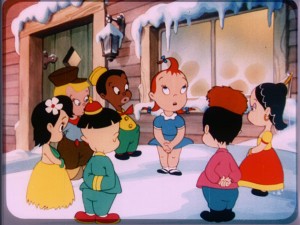 Santa’s Surprise (12/5/47) – Another sweet-natured cartoon for the holiday season. A proto-Little Audrey leads an international and interracial group of kids in an effort to do something nice for Santa, as he has been so nice to them. There are gags about a Dutch kid and his wooden shoes, and a black kid who offers to shine Santa’s boots with a boogie beat – two years before the “Chattanoogie Shoe Shine Boy” appeared in song. Santa wakes up to fina a Christmas tree set up in his house, and a Christmas gift for him – along with a note reminding him not to forget them next year. The proto-Audrey seems as yet a little less mischievous than we remember her from later episodes. Songs: “Merry Christmas To You”, an original sung by Santa, and “We’re Gonna Do Something for Santa Claus” another original sung by the kids as they set about tidying up Santa’s digs. Also “Deck the Halls” and “Jingle Bells”.
Santa’s Surprise (12/5/47) – Another sweet-natured cartoon for the holiday season. A proto-Little Audrey leads an international and interracial group of kids in an effort to do something nice for Santa, as he has been so nice to them. There are gags about a Dutch kid and his wooden shoes, and a black kid who offers to shine Santa’s boots with a boogie beat – two years before the “Chattanoogie Shoe Shine Boy” appeared in song. Santa wakes up to fina a Christmas tree set up in his house, and a Christmas gift for him – along with a note reminding him not to forget them next year. The proto-Audrey seems as yet a little less mischievous than we remember her from later episodes. Songs: “Merry Christmas To You”, an original sung by Santa, and “We’re Gonna Do Something for Santa Claus” another original sung by the kids as they set about tidying up Santa’s digs. Also “Deck the Halls” and “Jingle Bells”.
Merry Christmas to all! Next Post: Popeye 1945-46.


 James Parten has overcome a congenital visual disability to be acknowledged as an expert on the early history of recorded sound. He has a Broadcasting Certificate (Radio Option) from Los Angeles Valley College, class of 1999. He has also been a fan of animated cartoons since childhood.
James Parten has overcome a congenital visual disability to be acknowledged as an expert on the early history of recorded sound. He has a Broadcasting Certificate (Radio Option) from Los Angeles Valley College, class of 1999. He has also been a fan of animated cartoons since childhood.












































The Blackie cartoons, like all the early Noveltoons, are funny, entertaining, and very well made, if somewhat derivative. As you noted, “Sheep Shape” has much in common with Tex Avery’s “Red Hot Riding Hood”; and in “Much Ado About Mutton”, the wolf plays a jazzed-up rendition of “Mary Had a Little Lamb” on the trumpet to lure an innocent sheep into his clutches — which is exactly what was done in the Mighty Mouse cartoon “Wolf! Wolf!” three years earlier.
“The Enchanted Square” is a beautiful, moving cartoon, all the more so in the recent Thunderbean restoration, and I would love to see all the Noveltoons looking that good. So… still no sign of “Spree for All” in Cinecolor? I know we’re lucky to be able to see it at all, even in black and white, but still….
Santa’s Surprise was watched by me many times in my public domain DVD childhood. I now look at Famous Studios with frustration.
Oh Jerry, I’m excited about the Collector’s Choice, if you’re behind it!
Blackie clearly was Famous’ answer to Bugs Bunny, with none of the latter’s charm, wit, or panache. His catchphrase “Are you kiddin’?” was no “What’s up, doc?”
“The Enchanted Square” had the makings of a great cartoon. Typically, the Famous storytellers missed all the dramatic possibilities of a little blind girl stumbling around her shabby block (one of those colorful low-rent districts throughout New York City that were urban renewed out of existence a decade later), imagining it as a magic amusement park–particularly since it was Halloween. And the piercing final notes of “You Can See With Your Heart” at the end could set dogs off. It’s a charming cartoon just the same.
Famous meant well, and who’s to say the cartoons would have been that much better if the Fleischers had remained? Paramount was too much in charge. (The other studios barely acknowledged they even had animation departments.)
“The Enchanted Square” is certainly miles ahead of “Suddenly It’s Spring” on every front. It’s good enough to make one wonder why Raggedy Ann’s career ended there. Perhaps a reluctance to be dependent on ANOTHER character they didn’t own outright?
I’ve never seen mention of whether Famous (or the Fleischers, for that matter) got anything from the merchandising of Popeye, Lulu, or Superman to supplement actual film rentals. Casper, Audrey, and Herman & Katnip brought in comic book money at the very least, and were eventually salable to publisher Harvey.